When
viewing this exhibition be sure to take the notecards that are
available. On first looking at Adam Ramona's Basilica I
saw it as a purely abstract interactive sound sculpture. A
notecard that is dispensed on touching a nearby sign contains
what amounts to a short philosophical treatise on theories of
global justice. We learn not only how the title and colors of
the sculpture relate to justice issues, but also the sounds:
I have sourced the sounds of gunshots
(in particular the AK47, a symbol to some of the global terror
movement), bomb explosions and screams, manipulating the
harmonics according to a rational scale of my own devising, to
create a compellingly beautiful yet haunting sonic system.
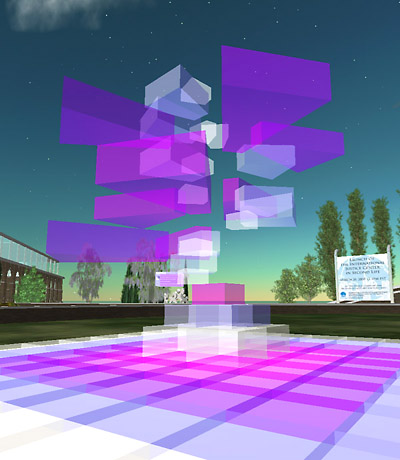
Adam Ramona's Basilica
Tuna
Oddfellow and Shava Suntzu created a large sphere containing
symbolic photographs and imagery with barbed wire strung across
the middle of it. Wear your antigrav and fly up to 550 meters, or
use the landmark provided on the notecard you received on entering
the exhibition. This is at the 550 meter level.
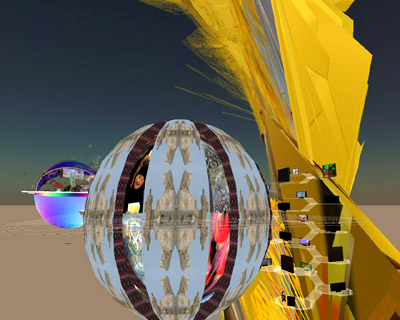
At 550 meters
you can visit the foreground sphere by Tuna Oddfellow and Shava
Suntzu, the sphere behind it by Josina Burgess,
Junivers Stockholm, Velazquez Bonetto, and DanCoyote's Hyperformalist
Flat Panels.
A
chilling sculpture that is also humorous is Tooter Claxton's insideOutJail002.
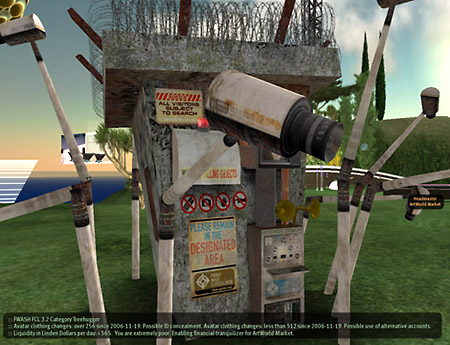
This
interactive work identifies you and shows a series of vaguely threatening
security messages in chat windows. It appears to have access to
much of your personal history, mixing bits of accessible real data
with fictional entries. Creepy and mesmerizing.
|
A
notecard is also needed to find a connection between Global
Justice and Nest of Light by Juria Yoshikawa. Flying into
the dark globe that is not far above ground level, I felt like I
was surrounded by masses of graffiti in both visual and
soundscapes. Be sure to use a flight feather or other
antigravity device when you are at this exhibition, as you will
need to hover at certain altitudes.

Inside Nest of Light
by Juria Yoshikawa
Juria writes,
"The word "justice" can mean many
things but to me, most of all, it starts with being true to
myself and searching for an internal spark I believe is the
beginning of creative truth."
After you go
through the gallery of 2D works, there is a ramp inside that
leads upward, as though to a second floor. But is you go up this
you find yourself outdoors, and the ramp simply ends.
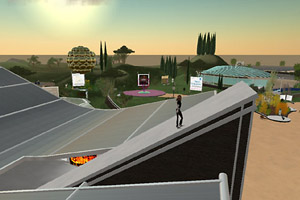
A ramp leads
from the interior of the gallery toward the sky
This is an
excellent example of SL architecture. The next place to go from
here is up. Although you have just been in what appears to be a
traditional real-world style building, quite appropriate for 2D
works made in RL and imported to SL, you now will put on your
antigrav and fly up, so the ramp sets you in that direction.
Or you can
simply fall off the end, which is what I did. Falling from
heights is such a pleasure in Second Life. When I landed the
next work I saw was Pavig Lok's The
Intellectual Property Garden.
This totally
black sculpture creates a silhouette from every angle.
Silhouettes are fascinating because all the detail must be
crated by your imagination. In this animated sculpture, a child appears
to be blowing bubbles, but the bubbles are copyright symbols: ©.
The plants are growing, and their flowers are also ©'s.
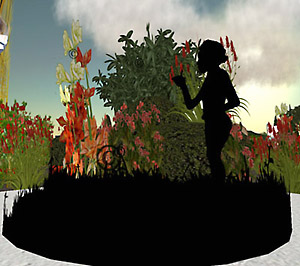
What does it
mean? Again a notecard comes to the rescue. Pavig
tells us:
A child is seen in a field blowing a
dandelion. The flower and seeds are composed of copyright
symbols, which can also be seen growing wild in the field. To
the child the dandelion represents making a wish. To the adult
it is a garden pest which stifles the growth of preferred
plants.
Following
this is a lengthy and interesting polemic
on intellectual property law.
|
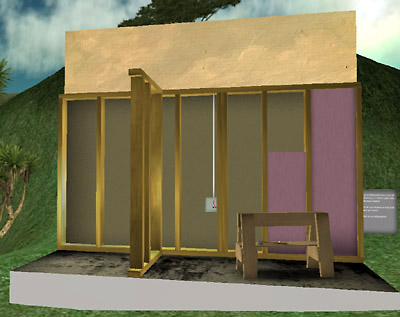 AM
Radio approached
the subject by looking at the government's response to victims
of natural disasters. Katrina (left) portrays the
remnants of a house after the hurricane, where all that's left
is exposed framing, wiring and insulation. Or is that as far as
they got in trying to rebuild? AM
Radio approached
the subject by looking at the government's response to victims
of natural disasters. Katrina (left) portrays the
remnants of a house after the hurricane, where all that's left
is exposed framing, wiring and insulation. Or is that as far as
they got in trying to rebuild?
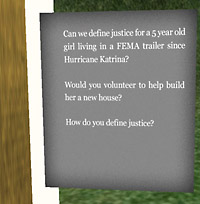 Each
of the works has a sign that puts the question to the viewer. Each
of the works has a sign that puts the question to the viewer.
In Barbed
Wire (below), AM portrays a farmscape using a painted
backdrop and a highly detailed sculpture of a fencepost, barbed
wire and a wire setting tool. The detail photo, shot an at
angle, helps show the quality of workmanship. The juxtaposition
of high realism in the sculpture with the impressionist
landscape creates a dreamlike space. It's not Surrealism, though
it has some roots there.
It is a form
that could exist in real life, but seems natural here in Second
Life, where a mix of reality and imagination is the norm.
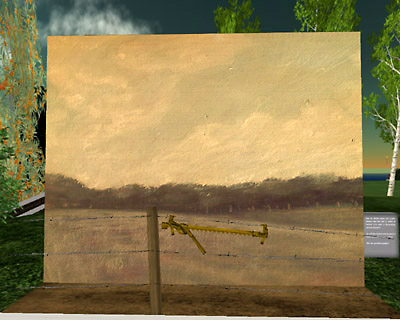 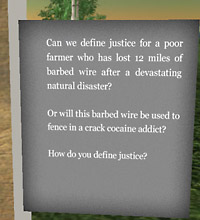
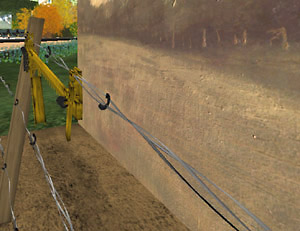
Teleport
now to Justice Commons
|